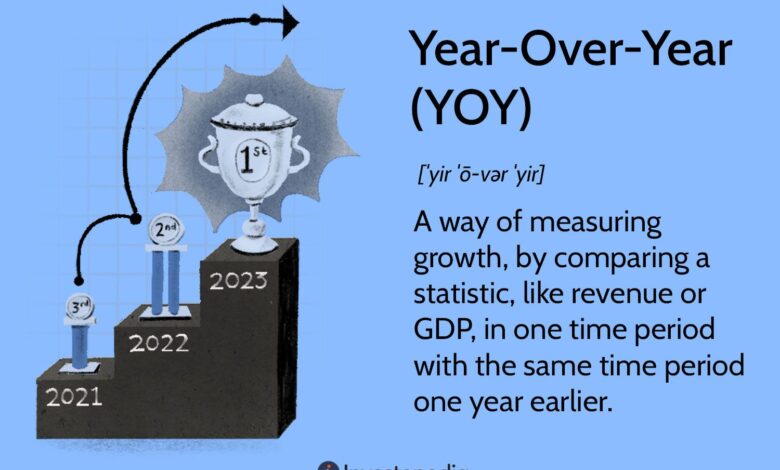Understanding the YOY Phenomenon: A Comprehensive Guide to Year-On-Year Growth

Defining YOY: What Does Year-On-Year Mean?
The term YOY, or Year-On-Year, is a financial metric that compares data from one year to data from the same time period in the previous year. This approach provides valuable insights into trends, growth, and overall performance across various sectors, including finance, business, and economics. The significance of YOY lies in its ability to eliminate seasonal effects, offering a clearer picture of performance over time.
To calculate YO.Y growth, the formula is relatively straightforward. It is expressed as follows:

YOY Growth (%) = ((Current Year Value – Previous Year Value) / Previous Year Value) x 100
For instance, if a company’s revenue for Q1 2023 was $500,000 and in Q1 2024 it increased to $600,000, the YO.Y growth would be calculated as follows:
YOY Growth (%) = (($600,000 – $500,000) / $500,000) x 100 = 20%
This indicates a 20% increase in revenue compared to the same quarter in the previous year. Understanding this metric is pivotal for businesses, as it aids in tracking performance and making informed decisions.
YOY is widely used in various applications, such as assessing quarterly earnings, sales, customer acquisition rates, and even economic growth rates. Financial analysts, investors, and business managers utilize YO.Y comparisons to evaluate performance and to benchmark against industry standards. By using YOY data, organizations can effectively spot trends, identify growth areas, and determine potential challenges, making it an essential concept in year-to-year evaluation.
In conclusion, comprehending the YO.Y concept not only enhances analytical capabilities but also equips individuals and businesses with the insights needed to thrive in competitive environments.
Importance of YOY Analysis in Business Metrics
Year-On-Year (YOY) analysis serves as a vital tool for businesses and investors, providing insights into growth trends and operational performance over time. By comparing data from one year to the next, organizations can effectively gauge their progress, align their strategies, and identify potential areas for improvement. Understanding these yearly metrics allows decision-makers to create forecasts that are grounded in historical performance rather than mere speculation.
The primary advantage of YO.Y analysis lies in its ability to eliminate seasonal fluctuations that may skew the perception of a company’s performance. Businesses often experience variations in sales and revenue based on seasonal demand and market conditions; thus, assessing growth on a yearly basis affords a clearer view of overall trajectory. This approach is particularly beneficial in industries where products or services have distinct seasonal peaks, enabling stakeholders to make informed comparisons across similar periods.
Real-world examples underscore the significance of YOY analysis. Consider a retail company that experiences a spike in sales during the holiday season. By employing YO.Y metrics, the company can discern whether the increase is a result of seasonal behavior or an actual improvement in customer engagement and brand loyalty. This clarity allows the business to develop targeted marketing strategies and optimize inventory management for future growth.
Moreover, YOY analysis facilitates investment decision-making for investors. They can assess a company’s financial health and operational efficiency by examining changes in key performance indicators over multiple years. This analysis empowers investors with insights into sustainable growth, enabling them to identify attractive investment opportunities and make well-informed choices.
In conclusion, the critical role of YO.Y analysis in measuring business performance cannot be overstated. By leveraging this method, companies and investors can navigate the complexities of market dynamics, ensuring that they are always strategically aligned with their goals and objectives.
Methods to Calculate and Interpret YOY Data
Calculating Year-On-Year (YOY) data involves comparing current metrics with their previous year’s figures to assess growth or decline over a specified period. This analysis can be applied to various elements such as sales, profits, and customer growth. To calculate YOY changes, follow these straightforward steps:
1. **Collect the Data**: Gather the data for both the current year and the previous year for the specific metric you are analyzing. For instance, if assessing sales, you would need total sales figures for both years.
2. **Use the YO.Y Calculation Formula**: The fundamental formula to calculate YOY growth is: \[ \text{YOY Change} = \left( \frac{\text{Current Year Value} – \text{Previous Year Value}}{\text{Previous Year Value}} \right) \times 100 \] This provides the percentage increase or decrease in the metric under review.
3. **Interpret the Results**: A positive percentage indicates growth, while a negative percentage suggests a decline. It is crucial to contextualize these changes, considering external factors that may have influenced the data.
However, there are potential pitfalls to be aware of when conducting YO.Y analysis. Seasonal fluctuations can significantly impact metrics, particularly in industries with pronounced seasonal trends. Consequently, adjustments may be necessary to ensure an accurate analysis of underlying performance. Moreover, external factors such as economic changes, market shifts, or company-specific events must be accounted for to avoid misleading interpretations.
To effectively interpret YOY data, it is essential to look beyond the numbers. Consider the broader market landscape and internal organizational shifts, as these elements can offer insights into the reasons behind the observed trends. By combining quantitative data with qualitative analysis, businesses can make more informed decisions driven by YO.Y information.

Applying YOY Trends: Strategies for Future Business Growth
Businesses can significantly benefit from analyzing year-on-year (YO.Y) trends as part of their strategic planning processes. By understanding the performance variations over different years, companies can identify patterns that signal growth opportunities or potential challenges. One actionable strategy involves utilizing YOY analyses during forecasting. By examining past performance data, businesses can make more informed predictions about future sales and market positioning, which enhances the accuracy of sales forecasts and operational planning.
Budgeting is another crucial area where YO.Y data can play a pivotal role. By analyzing historical financial performance, organizations can allocate resources more effectively and identify areas where operational adjustments might be necessary. For instance, if a company recognizes a consistent YOY decline in a particular product line, it may decide to reallocate funds towards more profitable segments, ultimately driving growth and sustainability.
Incorporating YOY metrics into operational decisions also allows businesses to adapt to changing market conditions proactively. By regularly tracking YO.Y performance across various departments, leaders can pinpoint underperforming areas and implement improvement strategies in real-time. This continuous monitoring fosters a culture of agility within the organization, enabling it to respond swiftly to market changes and customer demands.
To aid in the effective tracking of YO.Y metrics, businesses can leverage various tools and technologies. Analytics software and business intelligence platforms can automate data collection and analysis, providing real-time insights on performance indicators. These solutions not only simplify the YOY assessment process but also empower decision-makers with data-driven insights. Furthermore, integrating customer relationship management (CRM) systems can offer a comprehensive view of client interactions and performance trends, contributing to a more holistic understanding of the business landscape.
By employing these strategies, businesses can harness YOY trends to drive informed decisions. This approach not only enhances forecasting and budgeting but also supports long-term strategic growth initiatives.




